Hydrological Response to Precipitation and Human Activities—A Case Study in the Zuli River Basin, China
Abstract
1. Introduction
2. Materials and Methods
2.1. Study Area Description
2.2. Data Sources
2.3. Abrupt Change Point Analysis
2.4. Correlation Formula
2.5. Multiple Regression
3. Results
3.1. Variations of Hydrological Features
3.2. Changes in Soil Conservation Measures
3.3. Abrupt Change Point Analysis
3.4. The Effect of Runoff and Sediment Reduction Caused by Soil Conservation Measures
3.5. Contribution Rate
4. Discussion
5. Conclusions
Author Contributions
Funding
Acknowledgments
Conflicts of Interest
References
- Xu, X.; Yang, H.; Yang, D.; Ma, H. Assessing the impacts of climate variability and human activities on annual runoff in the Luan River basin, China. Hydrol. Res. 2013, 44, 940–952. [Google Scholar] [CrossRef]
- Fotovatikhah, F.; Herrera, M.; Shamshirband, S.; Chau, K.W.; Faizollahzadeh Ardabili, S.; Piran, M.J. Survey of Computational Intelligence as Basis to Big Flood Management: Challenges, research directions and Future Work. Eng. Appl. Comput. Fluid Mech. 2018, 12, 411–437. [Google Scholar] [CrossRef]
- Marshall, E.; Randhir, T. Effect of climate change on watershed system: A regional analysis. Clim. Chang. 2008, 89, 263–280. [Google Scholar] [CrossRef]
- Xu, J. Variation in annual runoff of the Wudinghe River as influenced by climate change and human activity. Quat. Int. 2011, 244, 230–237. [Google Scholar] [CrossRef]
- Taormina, R.; Chau, K.W.; Sivakumar, B. Neural network river forecasting through baseflow separation and binary-coded swarm optimization. J. Hydrol. 2015, 529, 1788–1797. [Google Scholar] [CrossRef]
- Li, L.; Zhang, L.; Wang, H.; Wang, J. Assessing the impact of climate variability and human activities on streamflow from the Wuding River basin in China. Hydrol. Process. 2007, 21, 3485–3491. [Google Scholar] [CrossRef]
- Huang, M.; Zhang, L. Hydrological Responses to Conservation Practices in a Catchment of the Loess Plateau, China. Hydrol. Process. 2004, 18, 1885–1898. [Google Scholar] [CrossRef]
- Wang, F.; Hessel, R.; Mu, X.; Maroulis, J. Distinguishing the impacts of human activities and climate variability on runoff and sediment load change based on paired periods with similar weather conditions: A case in the Yan River, China. J. Hydrol. 2015, 527, 884–893. [Google Scholar] [CrossRef]
- Mu, X.; Chille, B.; Zhang, L. Impact of soil conservation measures on runoff and sediment in Hekou-Longmen region of the Yellow River. J. Sediment Res. 2007, 2, 36–41. [Google Scholar] [CrossRef]
- Xu, J. Runoff Renewability in the Middle Yellow River in Response to Human Activity and Climate Change. J. Nat. Resour. 2015, 30, 423–432. [Google Scholar] [CrossRef]
- Kim, U.; Kaluarachchi, J.; Smakhtin, V. Climate Change Impacts on Hydrology and Water Resources of the Upper Blue Nile River Basin, Ethiopia; Research Report; International Water Management Institute, 2008; pp. 1231–1247. [Google Scholar]
- Wei, W.; Chen, L.; Fu, B. Water erosion response to rainfall and land use in different drought-level years in a loess hilly area of China. Catena 2010, 81, 24–31. [Google Scholar] [CrossRef]
- Ran, D. Water and Sediment Variation and Ecological Protection Measuresin the Middle Reach of the Yellow River. Yellow River 2006, 28, 93–100. [Google Scholar]
- Cheng, C.T.; Chau, K. Flood control management system for reservoirs. Environ. Model. Softw. 2004, 19, 1141–1150. [Google Scholar] [CrossRef]
- Wei, X.; Liu, W.; Zhou, P. Quantifying the relativecontributions of forest change and climatic variability to hydrologyin large watersheds: A critical review of research methods. Water 2013, 5, 728–746. [Google Scholar] [CrossRef]
- Ran, D. The response of Human Activities on the Water-Sediment-Changes in the Middle Yellow River. Rock Soil Mech. 2012, 11, 3351. [Google Scholar]
- Castillo, V.; Martinezmena, M.; Albaladejo, J. Runoff and Soil Loss Response to Vegetation Removal in a Semiarid Environment. Soil Sci. Soc. Am. J. 1997, 61, 1116–1121. [Google Scholar] [CrossRef]
- Liu, X.; Huang, M. Benefits of Water Reduction by Soil and Water Conservation in Different Physiognomy Type Areas of Big Scale Watershed. J. Soil Water Conserv. 2001, 1, 36–41. [Google Scholar] [CrossRef]
- Li, P.; Mu, X.; Holden, J. Comparison of soil erosion models used to study the Chinese Loess Plateau. Earth-Sci. Rev. 2017, 170, 17–30. [Google Scholar] [CrossRef]
- Wang, A.; Zhang, P. Effect of Soil an Water Conservation Measures on Surface Runoff in Watersheds. Res. Soil Water Conserv. 2008, 15, 18–20. [Google Scholar]
- Liu, X.; Yang, S.; Jin, S. The method to evaluate the sediment reduction from forest and grass land over large area in the loess hilly area. J. Hydraul. Eng. 2014, 20, 1039–1050. [Google Scholar] [CrossRef]
- Wang, F.; Zhao, G.; Mu, X. Regime Shift Identification of Runoff and Sediment Loads in the Yellow River Basin, China. Water 2014, 6, 3012–3032. [Google Scholar] [CrossRef]
- McVicar, T.; Niel, T.; Li, L. Spatially distributing monthly reference evapotranspiration and pan evaporation considering topographic influences. J. Hydrol. 2007, 338, 196–220. [Google Scholar] [CrossRef]
- Wu, C.L.; Chau, K.W. Rainfall–runoff modeling using artificial neural network coupled with singular spectrum analysis. J. Hydrol. 2011, 399, 394–409. [Google Scholar] [CrossRef]
- Chau, K.W. Use of Meta-Heuristic Techniques in Rainfall-Runoff Modelling. Water 2017, 9, 186. [Google Scholar] [CrossRef]
- Gao, P.; Mu, X.; Li, R. Analyses on trend and driving force of runoff andsediment load in the Wuding River. J. Sediment Res. 2009, 30, 22–28. [Google Scholar] [CrossRef]
- Wang, S.; Yan, Y.; Ming, Y.; Zhao, X. Quantitative estimation of the impact of precipitation and human activities on runoff change of the Huangfuchuan River Basin. J. Geogr. Sci. 2012, 22, 906–918. [Google Scholar] [CrossRef]
- Zhang, S.; Liu, S.; Mo, X. Impacts of precipitation variation and soil and water conservation measures on runoff andsediment yield in the Wuding River Basin, middle reaches of the Yellow River. J. Beijing For. Univ. 2010, 32, 161–168. [Google Scholar]
- Zhao, Y. Water and Sediment Variation Characteristics and Benefits of Water and Sediment Reduction of Soil Conservation in the Zuli River Basin; Gansu Agricultural University: Lanzhou, China, 2016. [Google Scholar]
- Gu, D.; Tan, B. Hydrological effects of human activities and research methods. J. China Hydrol. 1989, 5, 61–64. [Google Scholar]
- Baltagi, B. Multiple Regression Analysis. Biophotonics Int. 2009, 12, 47–48. [Google Scholar] [CrossRef]
- Xu, Z.; Cheng, L. Progress on studies and applications of the Distributed Hydrological Models. J. Hydraul. Eng. 2010, 41, 1009–1017. [Google Scholar] [CrossRef]
- Alansi, A.W.; Amin, M.S.M.; Halim, G.A. The effect of development and land use change on rainfall-runoff and runoff-sediment relationships under humid tropical condition: Case study of Bernam watershed Malaysia. Eur. J. Sci. Res. 2009, 31, 88–105. [Google Scholar]
- Cheng, Y.; He, H.; Cheng, N. The Effects of Climate and Anthropogenic Activity on Hydrologic Features in Yanhe River. Adv. Meteorol. 2016, 2016, 1–11. (In Chinese) [Google Scholar] [CrossRef]
- Gao, P.; Mu, X.; Wang, F. Changes in streamflow and sediment discharge and the response to human activities in the middle reaches of the Yellow River. Hydrol. Earth Syst. Sci. Discuss. 2010, 7, 347–350. [Google Scholar] [CrossRef]
- Zhang, M.; Wei, X.; Sun, P. The effect of forest harvesting and climatic variability on runoff in a large watershed: The case study in the Upper Minjiang River of Yangtze River basin. J. Hydrol. 2012, 464–465, 1–11. [Google Scholar] [CrossRef]
- Gao, P.; Li, P.; Zhao, B.; Xu, R. Use of double mass curves in hydrologic benefit evaluations. Hydrol. Process. 2017, 31, 4639–4646. [Google Scholar] [CrossRef]
- Mu, X.; Zhang, X.; Gao, P.; Wang, F. Theory of double mass curves and its applications in hydrology and meteorology. J. China Hydrol. 2010, 30, 47–51. [Google Scholar]
- Weber, K.; Stewart, M. A critical analysis of the cumulative rainfall departure concept. Ground Water 2004, 42, 935. [Google Scholar] [CrossRef]
- Lei, H. Comparison and Analysis on the Performance of Hydrological Time Series Change-point Testing Methods. Water Resour. Power 2007, 25, 36–40. [Google Scholar]
- Morrill, C.; Overpeck, J.; Cole, J. A Synthesis of Abrupt Changes in the Asian Summer Monsoon since the Last Deglaciation. Holocene 2003, 13, 465–476. [Google Scholar] [CrossRef]
- Zhao, F.; Xu, Z.; Huang, J. Long-term trend and abrupt change for major climate variables in the upper Yellow River Basin. Acta Meteorol. Sin. 2007, 21, 204–214. [Google Scholar]
- Xu, J. The water fluxes of the Yellow River to the sea in the past 50 years, in response to climate change and human activities. Environ. Manag. 2005, 35, 620–631. [Google Scholar] [CrossRef]
- Li, C.; Qi, J.; Wang, S.; Yang, L.; Yang, W.; Zou, S.; Zhu, G.; Li, W. A Holistic System Approach to Understanding Underground Water Dynamics in the Loess Tableland: A Case Study of the Dongzhi Loess Tableland in Northwest China. Water Resour. Manag. 2014, 28, 2937–2951. [Google Scholar] [CrossRef]
- Huang, W. Influence of inter-basin water diversion project to runoff of Zuli River Basin. Arid Land Geogr. 2008, 31, 743–749. (In Chinese) [Google Scholar] [CrossRef]
- Mu, X.; Zhang, L.; Mcvicar, T. Analysis of the impact of conservation measures on stream flow regime in catchments of the Loess Plateau, China. Hydrol. Process. 2008, 21, 2124–2134. [Google Scholar] [CrossRef]
- Trenberth, K. Changes in precipitation with climate change. Clim. Res. 2011, 47, 123–138. [Google Scholar] [CrossRef]
- Han, T.; Chen, S.; Qiao, L. Rainfall Variation in Zuli River Basin in the Past 50 Years and Influnence of Typical Human Activities. J. Arid Meteorol. 2009, 27, 220–226. [Google Scholar]
- Xin, Z.B.; Xu, J.X.; Yu, X.X. Temporal and spatial changes of soil erosion in loess plateau in recent 50 years. Acta Ecol. Sin. 2009, 29, 1129–1139. [Google Scholar]
- Li, C.; Qi, J.; Feng, Z. Quantifying the effect of ecological restoration on soil erosion in China’s Loess Plateau region: An application of the MMF approach. Environ. Manag. 2010, 45, 476–487. [Google Scholar] [CrossRef]
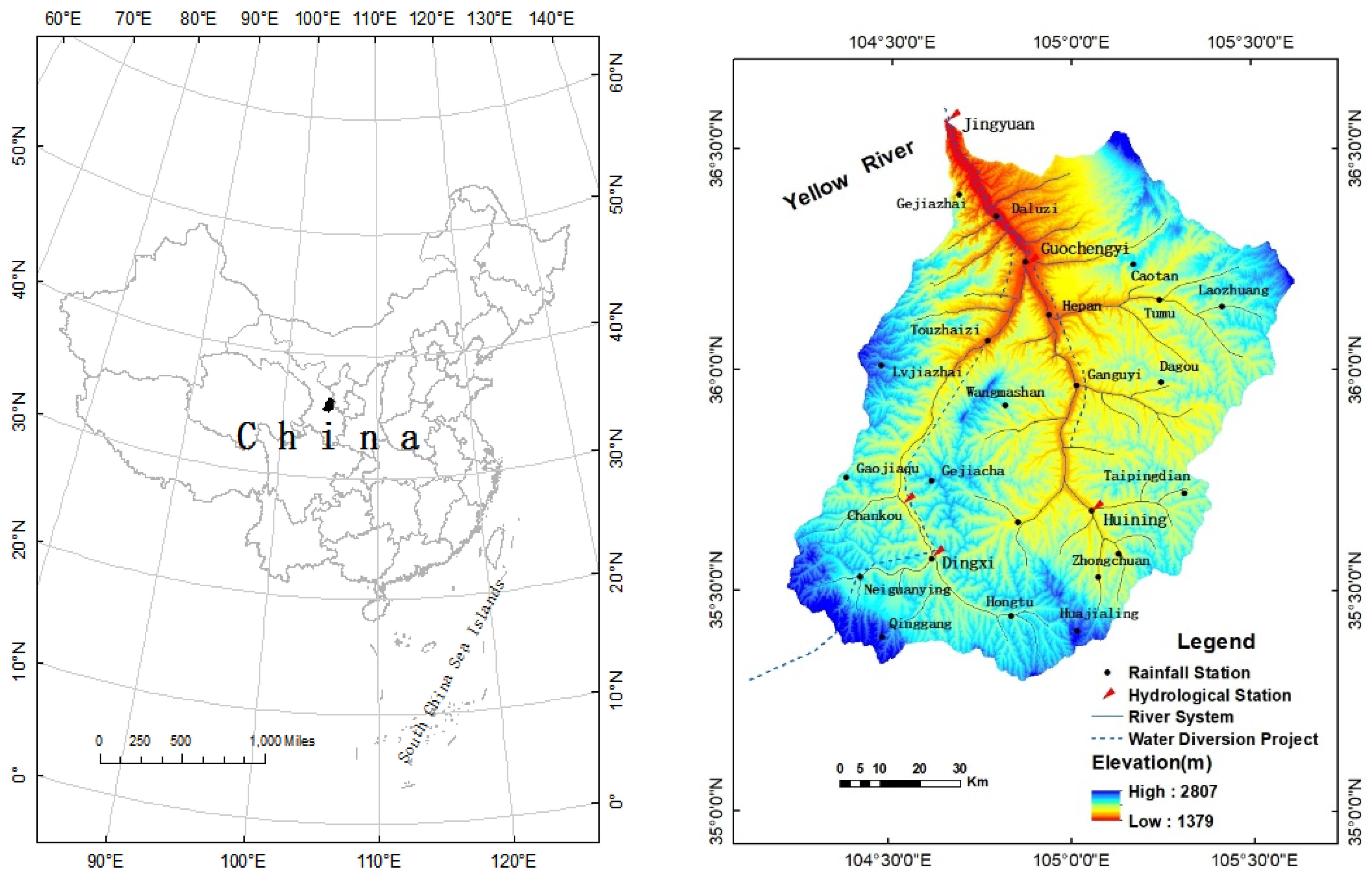
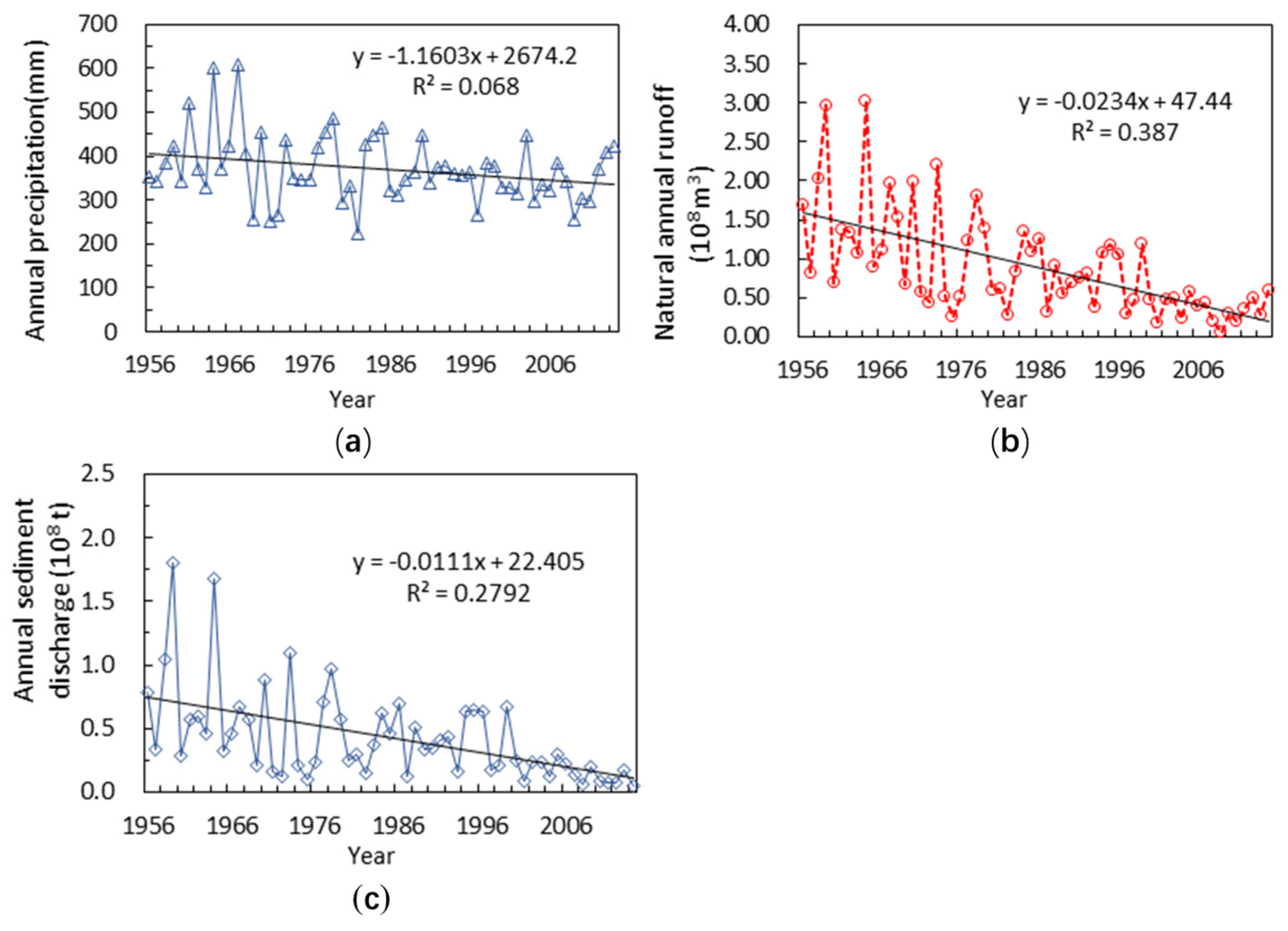
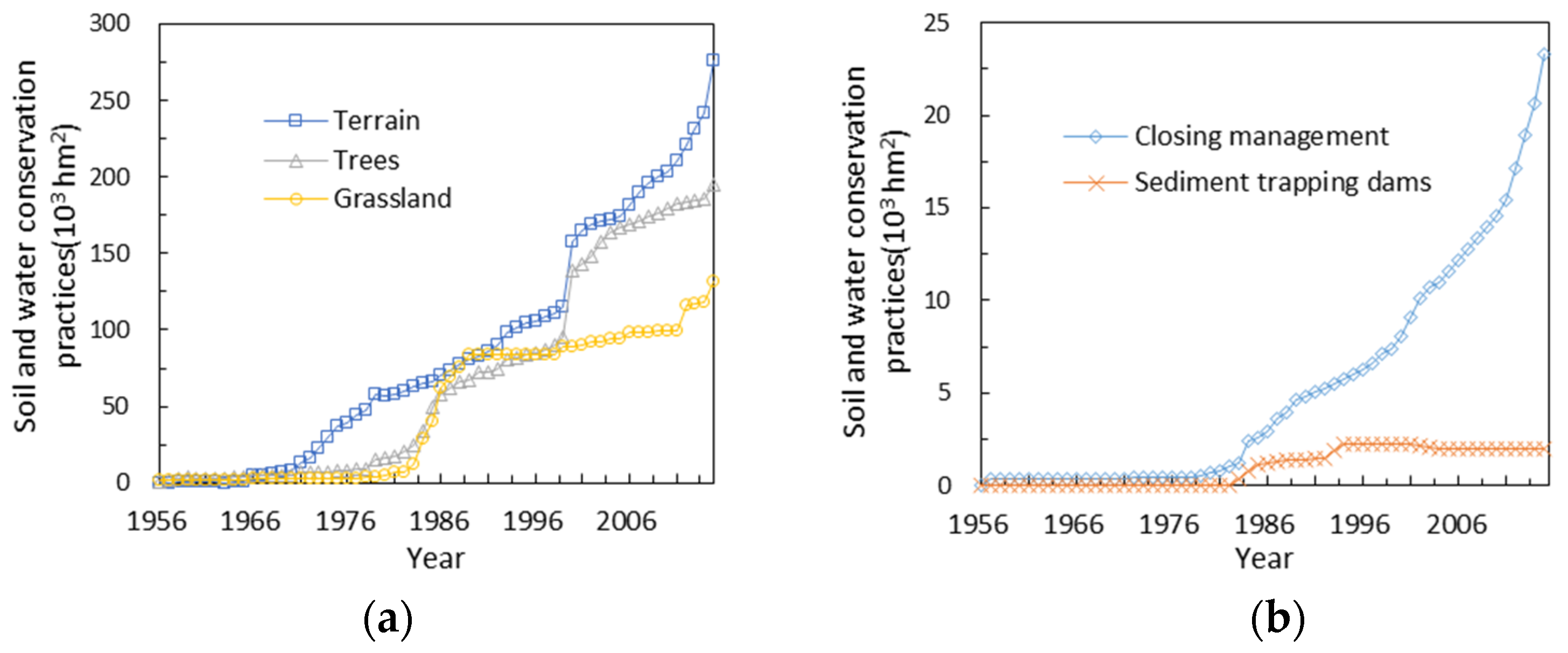
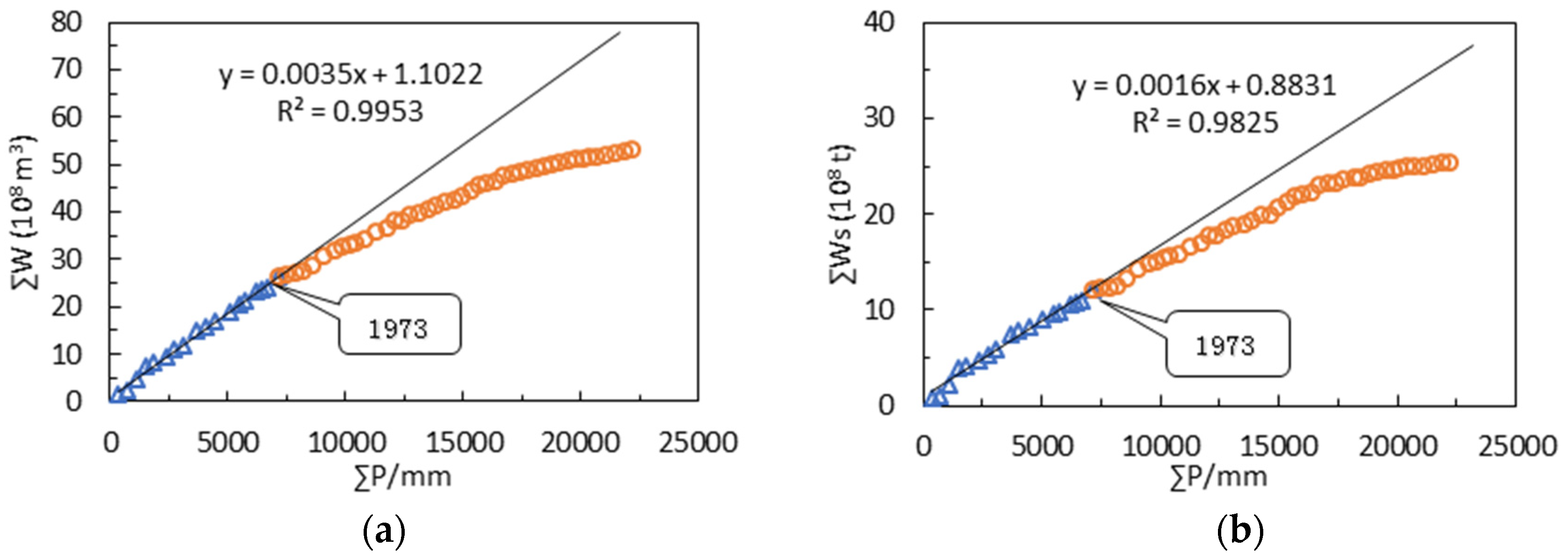
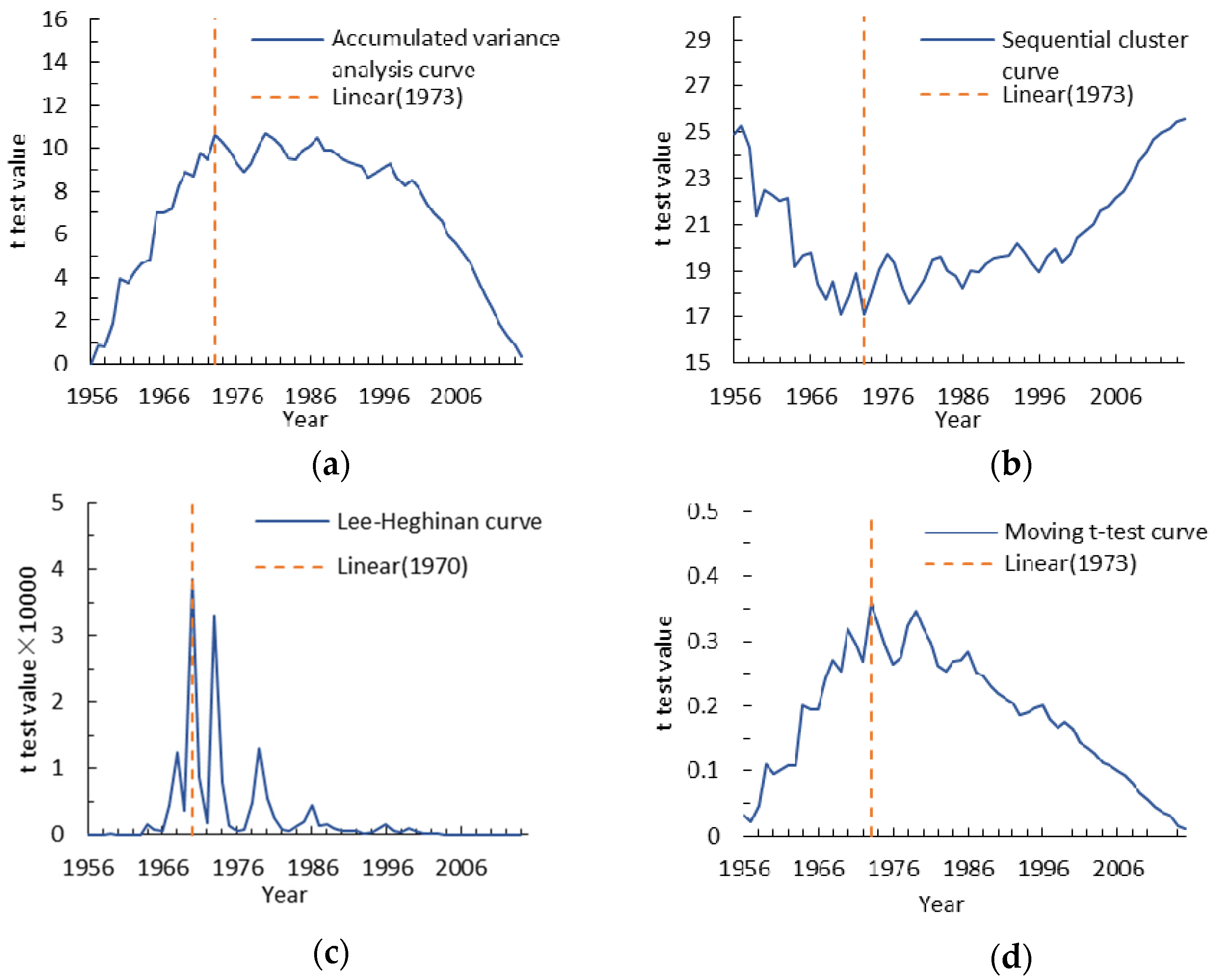

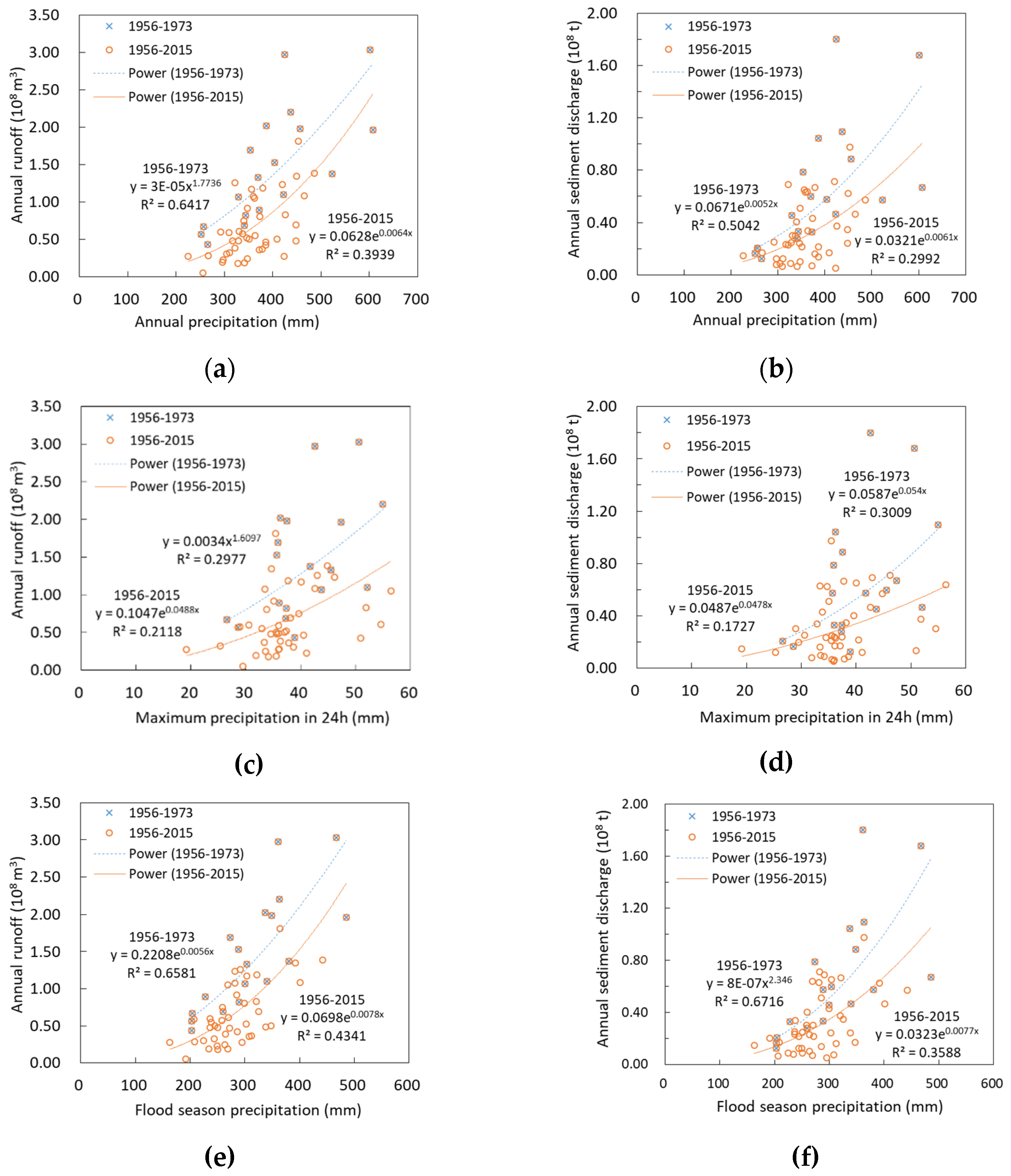
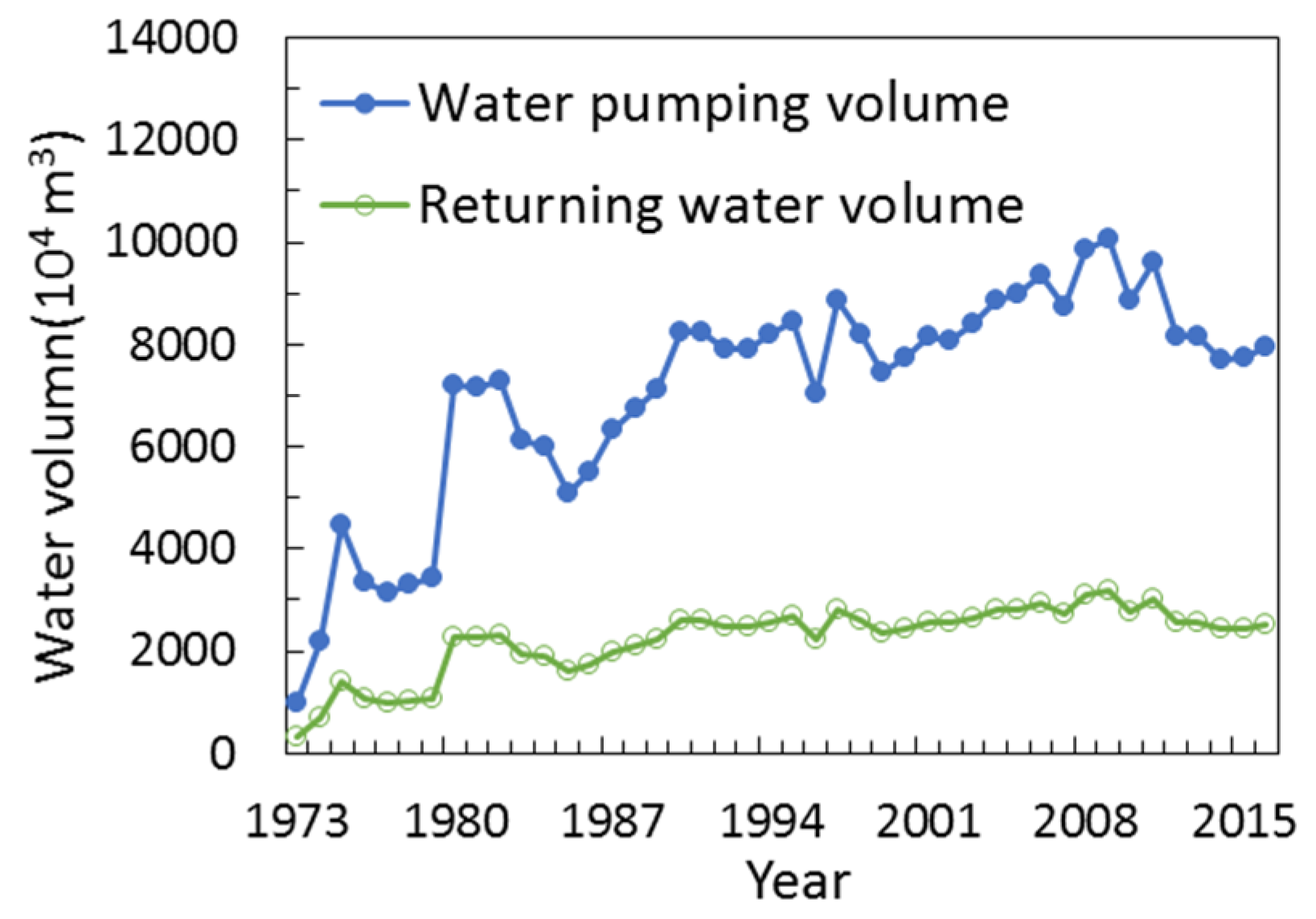
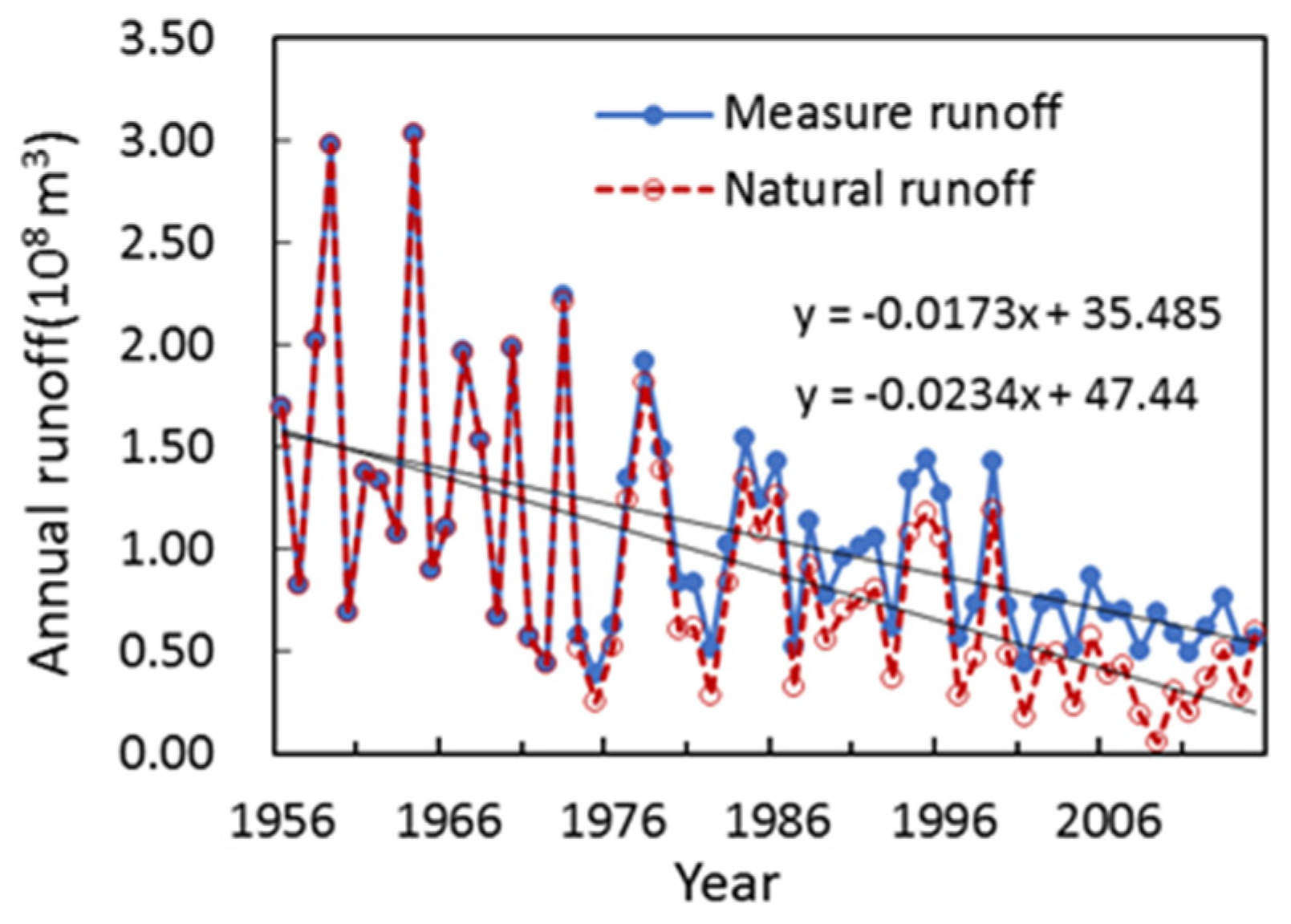
| Sequence | Category | Period | Data Description |
|---|---|---|---|
| 1 | Precipitation | 1956–2015 | Monthly and yearly precipitation data from 22 rainfall stations provided by the Hydrology Department of Gansu Province |
| 2 | Runoff | 1956–2015 | Monthly and yearly runoff data from Jingyuan station provided by the Hydrology Department of Gansu Province |
| 3 | Sediment | 1973–2015 | Monthly and yearly sediment load data from Jingyuan station provided by the Hydrology Department of Gansu Province |
| 4 | Water conservancy project | 1973–2015 | Water pumping volume of Jinghui inter-basin water diversion project provided by Jinghui Electric Irrigation Engineering Authority of Baiyin, Gansu Province |
| 5 | Soil conservation measures | 1973–2015 | Area statistics for soil conservation measures |
| 2011 | Soil conservation measures census results from Water Resources Department of Gansu Province |
| Series | Average Surface Precipitation | Runoff | Sediment Discharge | |||
|---|---|---|---|---|---|---|
| Annual (mm) | Coefficient of Variation (Cv) | Annual (108 m3) | Coefficient of Variation (Cv) | Annual (108 t) | Coefficient of Variation (Cv) | |
| Average | 370.0 | 0.20 | 0.8909 | 0.73 | 0.4232 | 0.84 |
| 1956–1979 | 409.5 | 0.24 | 1.4702 | 0.50 | 0.6932 | 0.64 |
| 1980–1989 | 353.2 | 0.20 | 0.7801 | 0.45 | 0.3823 | 0.47 |
| 1990–1999 | 364.8 | 0.12 | 0.7860 | 0.40 | 0.4313 | 0.45 |
| 2000–2009 | 332.1 | 0.15 | 0.3484 | 0.47 | 0.1863 | 0.40 |
| 2010–2015 | 350.6 | 0.15 | 0.3717 | 0.37 | 0.0870 | 0.44 |
| Period | Runoff (108 m3) | Sediment Discharge (108 t) | ||||
|---|---|---|---|---|---|---|
| Observed (108 m3) | Simulated (108 m3) | Reduction Effect (%) | Observed (108 t) | Simulated (108 t) | Reduction Effect (%) | |
| 1974–1979 | 0.9520 | 1.4783 | 35.6 | 0.4686 | 0.6292 | 25.5 |
| 1980–1989 | 0.7801 | 1.2266 | 36.4 | 0.3823 | 0.4977 | 23.2 |
| 1990–1999 | 0.7860 | 1.1947 | 34.2 | 0.4313 | 0.4688 | 8.0 |
| 2000–2009 | 0.3484 | 1.0079 | 65.4 | 0.1863 | 0.3778 | 50.7 |
| 2010–2015 | 0.3717 | 1.0943 | 66.0 | 0.0870 | 0.4242 | 79.5 |
| 1974–2015 | 0.6449 | 1.1840 | 45.5 | 0.3175 | 0.4705 | 32.5 |
| Period | Annual Precipitation (mm) | Annual Runoff (108 m3) | Runoff Reduction (108 m3) | Annual Sediment Discharge (108 t) | Sediment Discharge Reduction (108 t) | ||||
|---|---|---|---|---|---|---|---|---|---|
| Precipitation | Engineering Measures | Vegetation Measures | Precipitation | Engineering Measures | Vegetation Measures | ||||
| 1956–1973 | 396.8 | 1.465 | 0.67 | ||||||
| 1974–1979 | 400.5 | 0.952 | 0.1 | 0.126 | 0.002* | 0.469 | 0.032 | 0.075 | 0.009* |
| 1980–1989 | 353.2 | 0.78 | 0.384 | 0.173 | 0.255 | 0.382 | 0.127 | 0.103 | 0.103 |
| 1990–1999 | 364.8 | 0.786 | 0.47 | 0.197 | 0.19 | 0.431 | 0.158 | 0.117 | 0.076 |
| 2000–2009 | 332.1 | 0.348 | 0.517 | 0.229 | 0.368 | 0.186 | 0.175 | 0.135 | 0.149 |
| 2010–2015 | 350.6 | 0.372 | 0.535 | 0.244 | 0.269 | 0.087 | 0.182 | 0.143 | 0.109 |
| 1974–2015 | 357.3 | 0.645 | 0.47 | 0.207 | 0.232 | 0.317 | 0.158 | 0.123 | 0.094 |
| Year | Relative Contribution of Runoff Reduction | Relative Contribution of Sediment Reduction | ||||
|---|---|---|---|---|---|---|
| Precipitation | Engineering Measures | Vegetation Measures | Precipitation | Engineering Measures | Vegetation Measures | |
| 1974–1979 | 11.5 * | 62.1 | 49.4 | 9.5 * | 76.9 | 32.6 |
| 1980–1989 | 31.5 | 21.3 | 47.2 | 30.9 | 30.8 | 38.3 |
| 1990–1999 | 22.2 | 23.0 | 54.8 | 21.8 | 33.2 | 45.0 |
| 2000–2009 | 33.0 | 20.6 | 46.4 | 32.4 | 29.4 | 38.2 |
| 2010–2015 | 25.7 | 23.3 | 51.0 | 25.1 | 33.0 | 41.9 |
| 1974–2015 | 25.5 | 22.8 | 51.7 | 25.0 | 32.8 | 42.2 |
© 2018 by the authors. Licensee MDPI, Basel, Switzerland. This article is an open access article distributed under the terms and conditions of the Creative Commons Attribution (CC BY) license (http://creativecommons.org/licenses/by/4.0/).
Share and Cite
Huang, C.; Yang, Q.; Huang, W.; Zhang, J.; Li, Y.; Yang, Y. Hydrological Response to Precipitation and Human Activities—A Case Study in the Zuli River Basin, China. Int. J. Environ. Res. Public Health 2018, 15, 2780. https://doi.org/10.3390/ijerph15122780
Huang C, Yang Q, Huang W, Zhang J, Li Y, Yang Y. Hydrological Response to Precipitation and Human Activities—A Case Study in the Zuli River Basin, China. International Journal of Environmental Research and Public Health. 2018; 15(12):2780. https://doi.org/10.3390/ijerph15122780
Chicago/Turabian StyleHuang, Chenlu, Qinke Yang, Weidong Huang, Junlong Zhang, Yuru Li, and Yucen Yang. 2018. "Hydrological Response to Precipitation and Human Activities—A Case Study in the Zuli River Basin, China" International Journal of Environmental Research and Public Health 15, no. 12: 2780. https://doi.org/10.3390/ijerph15122780
APA StyleHuang, C., Yang, Q., Huang, W., Zhang, J., Li, Y., & Yang, Y. (2018). Hydrological Response to Precipitation and Human Activities—A Case Study in the Zuli River Basin, China. International Journal of Environmental Research and Public Health, 15(12), 2780. https://doi.org/10.3390/ijerph15122780




